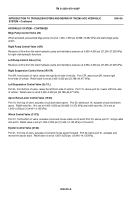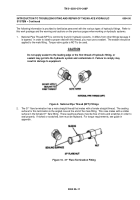TM-5-2350-378-24-P - Page 42 of 790
TM 5--2350--378--24&P
0004 00--17
INTRODUCTION TO TROUBLESHOOTING AND REPAIR OF THE M9 ACE HYDRAULIC
SYSTEM -- Continued
0004 00
NOTE
Before attempting to repair or replace any hydraulic component you must:
(a) Determine the maintenance responsibility for repair or replacement of the component.
(b) If the task is at your echelon of maintenance responsibility, you must identify the tools
needed and the replacement parts required.
Refer to the Maintenance Allocation Chart -- MAC to determine not only the maintenance
responsibility of the item, but also to obtain an estimate of the time required to perform the
task, tools needed, and any special notes/requirements necessary.
Refer to TM 5--2350--262--24P, Unit Direct Support and General Support Maintenance
Repair Parts and Special Tools List for requisition data concerning replacement parts for this
task.
Fluid leaks are classified as either Class I, Class II, or Class III.
Class I
Seepage of fluid, as indicated by wetness or discoloration, not great
enough to form drops.
Class II
Leakage of fluid great enough to form drops, but not enough to cause
drops to drip from the item being checked or observed.
Class III
Leakage of fluid great enough to form drops that fall from the item being
checked or observed.
PRELIMINARY TROUBLESHOOTING PROCEDURES
Before starting any specific troubleshooting procedures, perform the following procedures:
S
Visually check for ruptured oil hoses or tubes, and for Class II or Class III leaks. Replace any
damaged components.
S
Visually check both high--pressure filters and return line filter for cracks, loose fittings, damaged
hoses, and broken brackets. Replace or repair any damaged components.
S
Check for mechanical jamming or binding caused by rocks or other foreign matter.
S
Check oil level in hydraulic tank and service as necessary.
S
Check temperature of hydraulic oil at hydraulic oil temperature gauge in driver’s compartment.
Temperature should not be more than 180
±
F(82
±
C).
S
Check operation and adjustment of each hydraulic control and valve plunger (Figure 15, item 2).
Plungers should move 9/32 in (7 mm) above or below neutral position when control rod (Figure 15,
item 1) is operated. (Bilge pump and SPRUNG/UNSPRUNG plungers only move up).
Figure 15. Adjustment of Hydraulic Control and Valve Plunger
Back to Top




















